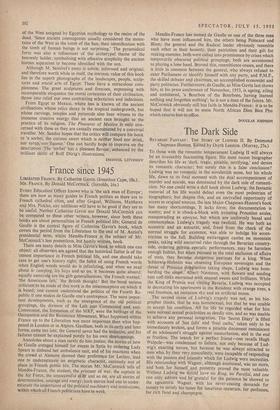Two Countries
THE GLORY OF EGYPT. By Samivel. With photographs by Michel Audrain. (Thames and Hudson, 42s.)
EGYPT has filled the museums of the world with fragments of a civilisation that seems retrospectively to have been an enormous necropolis. As one passes through the frescoed funeral chambers it is difficult to resist the feeling that the gold-sheathed dead 'were the aristocrats of Ancient Egypt and the living were their humble attendants. For 200 generations it was the dead who owned the prodigious treasures, and the quick poured wealth and creative genius into the tomb to make it beautiful and gilded the corpses to disguise the obscenity of putrefaction. So powerful are the monuments of these aristocratic dead that in their shadow. the Levantine city of Cairo appears a ramshackle intruder. ,The Ancient Egyptians were profoundly religious, but the heart of their mystery, their church, was the burial chamber. Life was the antechamber to death.
M. Samivel, in his imaginative and poetic essay on the meaning of the art and religion of Ancient Egypt which iritroduces a magnificent collection of Egyptian photographs, distributes the emphasis differently. 'No doubt,' he says, `the ideas of the Ancient Egyptians underwent many changes, for its apparent immobility is deceptive; but it appears to have been marked throughout its history by a stubborn, heroic battle against the transitory Present, against death, ultinlately against the very appearance of thjngs.'
He has some original things to say about the sixty pyramids that straggle down the centre of the lower Nile valley. He sees these as an artificial mountain barrier which formed the frontier of the West assigned by Egyptian mythology to the realm of the dead. 'Since ancient cosmogonies usually considered the moun- tains of the West as the tomb of the Sun, their identification with the tomb of human beings is not surprising.' The pyramidical form was also a refinement of the archetypal theme of the heavenly ladder, symbolising with effective simplicity the ancient human aspiration to become identified with the sun.
Although M. Samivel's essay is subtle, informed and original, and therefore worth while in itself, the intrinsic value of this book lies in the superb photographs of the landscapes, people, sculp- tures and mural arts of Egypt. These have a miraculous com- pleteness. The great sculptures and frescoes, expressing with incomparable eloquence the moral certainties of their civilisation, throw into relief our own contrasting eclecticism and indecision.
From Egypt to Mexico, where less is known of the ancient civilisations whose relics decay in the tropical undergrowth, but whose carvings, temples and pyramids also bear witness to the immense creative energy that an ancient race brought to the practice of its religion. The Pleasures of Mexico is only con- cerned with these as they are casually encountered by a convivial traveller. Mr. Sandoz hopes that the critics will compare his book to 'a sorbet, the curious sweet which is neither food nor drink, nor syrup, nor liqueur.' One can hardly hope to improve on the description. The 'sorbet' has a pleasant flavour, enhanced by the brilliant decor of Rolf Durig's illustrations.
EMANUEL LITVINOFF



































 Previous page
Previous page